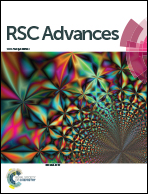A new complex alkali metal aluminium amide borohydride, Li2Al(ND2)4BH4: synthesis, thermal analysis and crystal structure†
Abstract
The mixtures of alkali metal aluminium amide MAl(ND2)4 and alkali metal borohydride MBH4 were synthesized using ball-milling. Thermal analysis and phase identifications of the MAl(ND2)4–MBH4 system were performed by differential scanning calorimetry-thermogravimetric analysis, temperature programmed desorption-residual gas analysis, in situ synchrotron radiation powder X-ray diffraction and Fourier transform infrared spectroscopy. A previously unknown phase, Li2Al(ND2)4BH4, was formed in the samples of LiAl(ND2)4 + 2LiBH4 and NaAl(ND2)4 + 2LiBH4. Its crystal structure was solved and refined in the monoclinic space group P21/c, with a = 6.8582(3) Å, b = 11.3128(5) Å, c = 11.2117(4) Å, β = 124.186(5)°. Li2Al(ND2)4BH4 is the first reported compound containing both [Al(ND2)4]− and BH4− anions. The ball-milling of NaAl(ND2)4 + 2NaBH4 and KAl(ND2)4 + 2KBH4 gave mixtures of the starting materials. The synthesized samples desorbed ammonia in the temperature range between 50 and 200 °C and hydrogen above ∼300 °C.


 Please wait while we load your content...
Please wait while we load your content...